SUNDRE – In rural communities throughout the province, smaller fire departments regularly respond to provide first aid during medical emergencies until an ambulance arrives.
While that isn’t new, there more recently seems to be a growing trend toward longer wait times for paramedics to arrive in the face of ambulance shortages, increasingly putting strain on firefighters who are more frequently finding themselves in a position to continue providing first aid for potentially long periods of time until a patient can finally be transported to hospital.
By way of motion, the municipal council recently directed administration to write a letter of support in solidarity with concerns expressed by Town of Ponoka Mayor Kevin Ferguson to Health Minister Jason Copping as well as Premier Danielle Smith and leader of the Opposition Rachel Notley, among others.
The letter dated Nov. 23 and signed by Ferguson outlines Ponoka’s concerns by way of recounting a couple of harrowing experiences, including one that involved their fire department’s members making a difficult decision to load up into a pickup and under police escort transport to hospital a patient who had been seizing after being struck by a vehicle with no ambulance nearby.
“The complete absurdity of this situation, I find astounding,” wrote Ferguson.
The Albertan sought comment from Sundre Fire Department Chief Ross Clews to see how the situation here compares.
“Provincewide right now, ambulance wait times – you see it on the news every day that people are complaining; our ambulance wait times are absolutely no different,” said Clews.
“It’s quite common for our (estimated time of arrival) of the ambulances to be between 20 and 40 minutes at time of call, on a majority of calls. That’s why we respond.”
In a year-to-date statistical break down of calls received by the local fire department dating to the end of November, there had been a total of 328 calls, of which 163 were medical assists – pretty well half of the total call volume.
“There’s some calls where a two-person or a three-person ambulance crew have a difficulty running the call – on echoes, cardiac arrests where CPR is involved and everything else like that,” he said. “That’s where extra people are helpful.”
Asked for his thoughts on the situation in Ponoka as described by that municipality’s mayor, Clews said the Sundre Fire Department would be reluctant to load up and transport a patient themselves.
“My crews will not transport a patient unless they’re in contact with a doctor and are ordered to do so by the doctor,” he said. “We’re not designed to transport a patient. We do not have the units that can allow for firefighters to work on a patient if needed in transport mode.”
Aside from not being properly set up to transport patients, Clews said there’s also the matter of “assuming a whole pile of liability. We’re not covered to transport patients.”
So to provide firefighters a level of relief when responding to medical emergencies, the chief is eyeing a new automatic chest compression device known as a LUCAS (Lund University Cardiac Assist System) CPR machine.
“We’re going to be looking at purchasing one of those this coming year,” he said.
The units can cost more than $20,000.
“It’s not the first one in the county,” he said, adding the Olds Fire Department already has a unit.
But once in the Sundre department’s hands, the device is expected to help alleviate the pressure faced by fire crews when tending to a patient on a medical response until an ambulance arrives.
“There was no other equipment for that, other than a person with their shoulders,” he said, referring to manually conducting compressions.
The automatic CPR machine not only offers continuous consistency on timing and strength of compressions but also crucially frees up the hands of firefighters so they can focus elsewhere on the patient or tend to other patients at the scene.
Clews expressed optimism that Alberta Health Services (AHS) will eventually get a handle on the situation.
“One of these days, AHS will get their ambulance system where they want it; where it should be,” he said, confident it’s less a matter of “if” and more a matter of “when.”
With the yuletide season fast approaching as people prepare to celebrate Christmas and ring in the new year, Sundre’s fire chief extended to the community his wishes for a safe, healthy and happy holiday, and reminds everyone to play safe when having fun.



